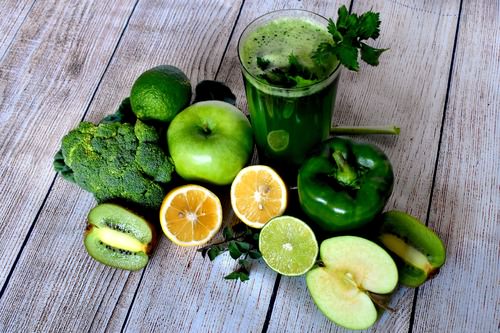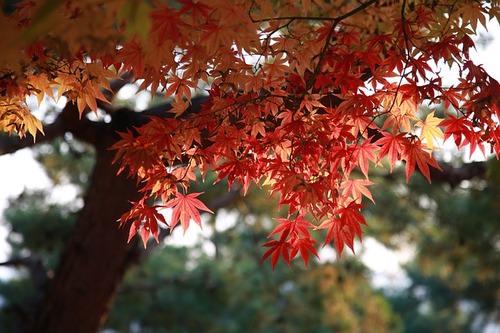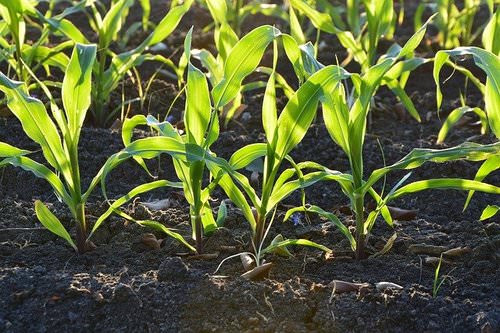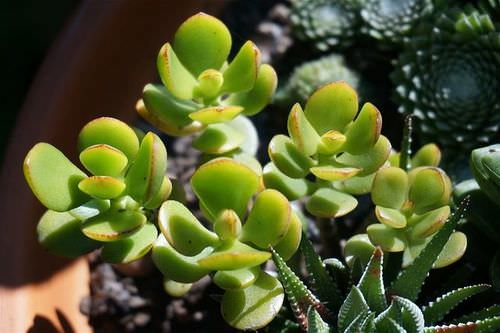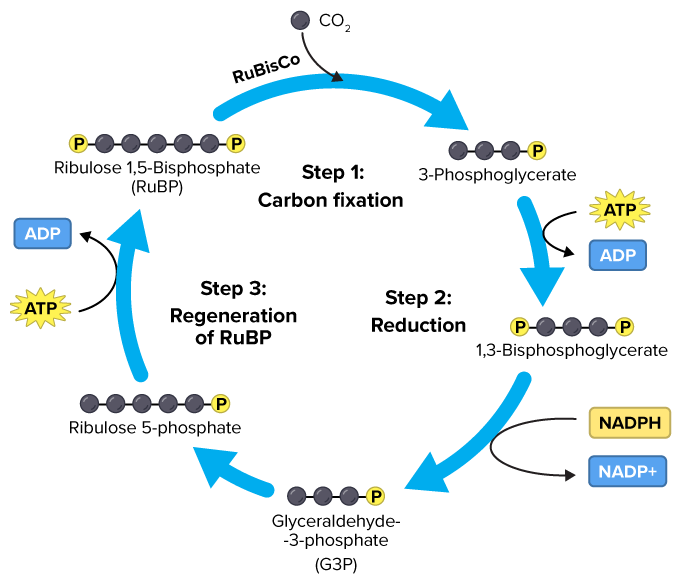2.22 卡尔文周期
章节大纲
-
What you will learn
::你会学到什么-
How the Calvin cycle fixes carbon and synthesizes
glucose
::卡尔文循环如何修补碳和合成葡萄糖 -
What happens in the three pathways for
carbon fixation
: C3, C4, and CAM pathways
::碳固碳的三种途径:C3、C4和CAM途径 -
How
RuBisCo
fixes carbon
::RRBisCo 如何修正碳
Other than being green, what do all these fruits and vegetables have in common?
::除了绿色之外,这些水果和蔬菜有什么共同点?They are full of energy . Energy in the form of glucose. The energy from sunlight is briefly held in NADPH and ATP , which is needed to drive the formation of sugars such as glucose. And this all happens in the Calvin cycle.
::它们充满了能量。能量以葡萄糖的形式呈现出来。阳光的能量在NADPH和ATP中短暂保存,这需要用来推动葡萄糖等糖的形成。所有这些都发生在卡尔文周期。The Calvin Cycle
::卡尔文周期Making Food “From Thin Air”
::制作食品“从薄空气”You’ve learned that the first, light-dependent stage of uses two of the three reactants , and light, and produces one of the products, oxygen gas (a waste product of this process). All three necessary conditions are required – chlorophyll pigments, the “theater,” and catalysts . The first stage transforms light energy into chemical energy, stored to this point in molecules of ATP and NADPH. Look again at the overall equation below. What is left?
::你已经知道,使用三个反应器中两个反应器的第一个、依赖光的使用阶段,以及光和生产一个产品、氧气(这一过程的废气产品 ) 。 所有三个必要条件都是必不可少的 — — 叶绿素色素、“戏剧 ” 和催化剂。 第一阶段将光能转化为化学能源,储存到ATP和NADPH分子中。 再看看下面的总体等式。 剩下的是什么?Waiting in the wings is one more reactant, carbon dioxide, and yet to come is the star product, which is food for all life – glucose. These key players perform in the second act of the photosynthesis drama, in which food is “made from thin air!”
::在机翼中等待是又一个反应力,二氧化碳,而未来的是恒星产品,即所有生命的食物 — — 葡萄糖。 这些关键玩家在光合作合剧的第二幕表演中表现了“用薄空气制造的”食物。CAN YOU FORM THE EQUATION The second stage of photosynthesis can proceed without light, so its steps are sometimes called “light-independent” or “dark” reactions (though the term ‘‘dark’’ reactions can be misleading). Many biologists honor the scientist, Melvin Calvin, who won a 1961 for working out this complex set of chemical reactions , naming it the Calvin cycle .
::光合作用第二步可以在没有光线的情况下进行,因此其步骤有时被称为“轻度独立”或“黑暗”反应(尽管“dark”反应一词可能误导人 ) 。 许多生物学家向科学家梅尔文·卡尔文致敬,他因研究这一系列复杂的化学反应而赢得1961年的胜利,并称之为卡尔文周期。The Calvin cycle has two parts. First carbon dioxide is ‘‘fixed’’. Then ATP and NADPH from the provide energy to combine the fixed carbons to make sugar.
::卡尔文周期有两个部分。 第一次二氧化碳是固定的。 然后ATP和NADPH从提供能源, 将固定碳结合制糖。Carbon Dioxide is “Fixed”
::二氧化碳是“固定的”Why does carbon dioxide need to be fixed? Was it ever broken?
::为什么二氧化碳需要固定?它曾经被打破过吗?Life on Earth is carbon-based. Organisms need not only energy but also carbon atoms for building bodies. For nearly all life, the ultimate source of carbon is carbon dioxide (CO 2 ), an inorganic molecule. CO 2 makes up less than 1% of the Earth’s atmosphere .
::地球上的生命是碳基的。 生物体不仅需要能源,还需要碳原子来建造身体。 几乎所有生命中,最终的碳来源都是二氧化碳(CO2 ) , 一种无机分子。 二氧化碳占地球大气的不到1%。and most other heterotrophs cannot take in CO 2 directly. They must eat other organisms or absorb organic molecules to get carbon. Only autotrophs can build low-energy inorganic CO 2 into high-energy organic molecules like glucose. This process is carbon fixation .
::大部分其他的异性营养化物质不能直接吸收二氧化碳。 它们必须吃掉其他有机体或吸收有机分子以获得碳。 只有自发营养可以将低能量无机二氧化碳培养成高能有机分子,比如葡萄糖。 这个过程就是固碳。Stomata on the underside of leaves take in CO2 and release water and O2. Guard cells close the stomata when water is scarce. Leaf cross-section (above) and stoma (below). Plants have evolved three pathways for carbon fixation.
::植物已经形成了碳固化的三个途径。The most common pathway combines one molecule of CO 2 with a 5-carbon sugar called ribulose biphosphate (RuBP). The enzyme which catalyzes this reaction (nicknamed RuBisCo ) is the most abundant enzyme on Earth! The resulting 6-carbon molecule is unstable, so it immediately splits into two 3-carbon molecules. The 3 carbons in the first stable molecule of this pathway give this largest group of plants the name “C 3 .”
::最常见的路径是将一个二氧化碳分子与一个称为肋骨双磷酸盐(RuBP)的5碳糖混合在一起。催化这种反应的酶(Nickname RuBisCo)是地球上最丰富的酶。 由此产生的6碳分子不稳定,因此立即分裂成两个3碳分子。 这条路径第一个稳定分子中的3碳给这个最大的植物组命名为“C3 ” 。Dry air, hot temperatures, and bright sunlight slow the C 3 pathway for carbon fixation. This is because stomata , tiny openings under the leaf which normally allow CO 2 to enter and O 2 to leave, must close to prevent loss of water vapor ( Figure ). Closed stomata lead to a shortage of CO 2 . Two alternative pathways for carbon fixation demonstrate biochemical adaptations to differing environments.
::干燥空气、热温和明光阳光减缓了碳固碳的C3路径。 这是因为通常允许二氧化碳进入和氧排放的叶子下的细小开口斯托玛塔必须接近防止水蒸气流失(图 ) 。 封闭的stomata导致二氧化碳的短缺。 固碳的两种替代途径表明对不同环境的生化适应。Plants such as corn solve the problem by using a separate compartment to fix CO 2 . Here CO 2 combines with a 3-carbon molecule, resulting in a 4-carbon molecule. Because the first stable organic molecule has four carbons, this adaptation has the name C 4 . Shuttled away from the initial fixation site, the 4-carbon molecule is actually broken back down into CO 2 , and when enough accumulates, RuBisCo fixes it a second time! Compartmentalization allows efficient use of low concentrations of carbon dioxide in these specialized plants.
::玉米等植物通过使用单独的隔板来修复CO2来解决问题。 这里的CO2与3碳分子结合, 产生了一个4碳分子。 因为第一个稳定的有机分子有四个碳分子, 这个适应性的名称是C4。 关闭了最初的固定地点, 4碳分子实际上又被折成CO2, 当足够积聚时, RuBisco 第二次修补它! 复合化使得这些专门工厂能够高效使用低浓度的二氧化碳。Cacti and succulents such as the jade plant avoid water loss by fixing CO 2 only at night. These plants close their stomata during the day and open them only in the cooler and more humid nighttime hours. Leaf structure differs slightly from that of C 4 plants, but the fixation pathways are similar. The family of plants in which this pathway was discovered gives the pathway its name, Crassulacean Acid Metabolism , or CAM ( Figure ). All three carbon fixation pathways lead to the Calvin cycle to build sugar.
::Cacti 和 succulents, 如玉树厂等, 避免水流失, 仅在晚上固定二氧化碳 。 这些工厂白天关闭其stomata, 只在更冷和更潮湿的夜间时间开放。 叶结构与 C4 工厂略有不同, 但固定路径相似 。 发现这条路径的工厂家族给路径命名为 Crassulacan酸代谢, 或 CAM( Figure ) 。 所有三个碳固定路径都通往卡尔文的糖生产周期 。-
Even chemical reactions adapt to specific environments! Carbon fixation pathways vary among three groups. Temperate species use the C3 pathway
::碳固化途径在三个组之间各有不同。 -
C4 species concentrate CO2 in a separate compartment to lessen water loss in hot bright climates
::C4物种将CO2浓缩在一个单独的区块内,以减少炎热气候中的缺水 -
Desert plants (jade plant, right) fix CO2 only at night, closing stomata in the daytime to conserve water.
::沙漠植物(jade植物,右)只在夜间修补二氧化碳,白天关闭stomata,以节水。
How Does the Calvin Cycle Store Energy in Sugar?
::Calvin循环能源库如何在糖里储存?As Melvin Calvin discovered, carbon fixation is the first step of a cycle. Like an electron transport chain , the Calvin cycle, shown in Figure , transfers energy in small, controlled steps. Each step pushes molecules uphill in terms of energy content. Recall that in the electron t ransport chain, excited electrons lose energy to NADPH and ATP. In the Calvin cycle, NADPH and ATP formed in the light reactions lose their stored chemical energy to build glucose.
::正如梅尔文·加尔文所发现的那样,碳固定是一个循环的第一步。像电子运输链,卡尔文循环,如图所示,以小的、受控制的步骤转移能量。每一步将分子从能量含量上推向上坡。回顾在电子运输链中,兴奋电子失去能量给NADPH和ATP。在卡尔文循环中,在光反应中形成的NADPH和ATP失去了储存的化学能量来制造葡萄糖。DID YOU KNOW? Scientists have designed artificial photosynthesis which is a way to convert carbon dioxide into fuel that can be used for internal combustion engines by capturing and storing the energy from the sun. Use the Figure to identify the major aspects of the process:
::利用该图确定进程的主要方面:-
the general cycle pattern
::一般周期模式 -
the major reactants
::主要中继者 -
the products
::产品 产品 产品 产品 产品 产品 产品 产品 产品 产品 产品 产品 产品 产品 产品 产品 产品 产品 产品 产品 产品 产品 产品 产品 产品 产品 产品 产品 产品 产品 产品 产品 产品 产品 产品 产品 产品 产品 产品 产品 产品 产品 产品 产品 产品
Overview of the Calvin Cycle Pathway First, notice where carbon is fixed by the enzyme nicknamed RuBisCo. In C 3 , C 4 , and CAM plants, CO 2 enters the cycle by joining with 5-carbon ribulose bisphosphate to form a 6-carbon intermediate, which splits (so quickly that it isn’t even shown!) into two 3-carbon molecules.
::首先,通知碳由被称为Ru BisCo的酶来固定。 在C3, C4 和 CAM 工厂中,二氧化碳与5-碳的肋骨磷酸酯结合进入循环,形成6-碳中间体,该中间体分裂成两个3-碳分子(甚至没有显示! ) 。Now look for the points at which ATP and NADPH (made in the light reactions) add chemical energy (“Reduction” in the diagram) to the 3-carbon molecules. The resulting “half-sugars” can enter several different metabolic pathways. One recreates the original 5-carbon precursor, completing the cycle. A second combines two of the 3-carbon molecules to form glucose, universal fuel for life.
::现在看看ATP和NADPH(以光反应制成)在3碳分子中添加化学能源(图中为“减少”)的点。 由此产生的“ 半糖” 可以进入几种不同的代谢途径。 一个可以重建原5碳先质, 完成循环。 第二个将2个3碳分子组合成葡萄糖, 即生命的通用燃料。The cycle begins and ends with the same molecule, but the process combines carbon and energy to build – food for life.
::循环以同一个分子开始和结束,但这一过程将碳和能源结合起来,以构建生命换食物。So, how does photosynthesis store energy in sugar? Six “turns” of the Calvin cycle use chemical energy from ATP to combine six carbon atoms from six CO 2 molecules with 12 “hot hydrogens” from NADPH. The result is one molecule of glucose, C 6 H 12 O 6 .
::光合作用如何将能量储存在糖中?6个Calvin周期的“翻转”利用ATP的化学能量将6个二氧化碳分子的6个碳原子与NADPH的12个“热氢”结合起来。结果是葡萄糖的一个分子,C6H12O6。Check your understanding!
::检查你的理解!
Summary
::摘要-
The reactions of the Calvin cycle add carbon (from carbon dioxide in the atmosphere) to a simple five-carbon molecule called RuBP.
::卡尔文周期的反应将碳(来自大气中的二氧化碳)添加到一个叫RUBP的简单五碳分子中。 -
These reactions use chemical energy from NADPH and ATP that were produced in the light reactions.
::这些反应使用来自NADPH和ATP的化学能量,这些化学能量是在光反应中产生的。 -
The final product of the Calvin cycle is glucose.
::卡尔文周期的最终产品是葡萄糖。
Review
::回顾-
What happens during the carbon fixation step of the Calvin cycle?
::卡尔文周期的碳固碳步骤期间会发生什么? -
What is special about RuBisCo?
::鲁比斯可有什么特别之处? -
What are stomata?
::什么是斯托马塔? -
Explain what might happen if the third step of the Calvin cycle did not occur. Why?
::解释一下,如果卡尔文周期的第三步没有发生,会发生什么。为什么? -
What is the main final product of the Calvin cycle? How many turns of the Calvin cycle are needed to produce this product?
::卡尔文周期的主要最终产品是什么? 生产这一产品需要卡尔文周期的多少转弯?
-
How the Calvin cycle fixes carbon and synthesizes
glucose
